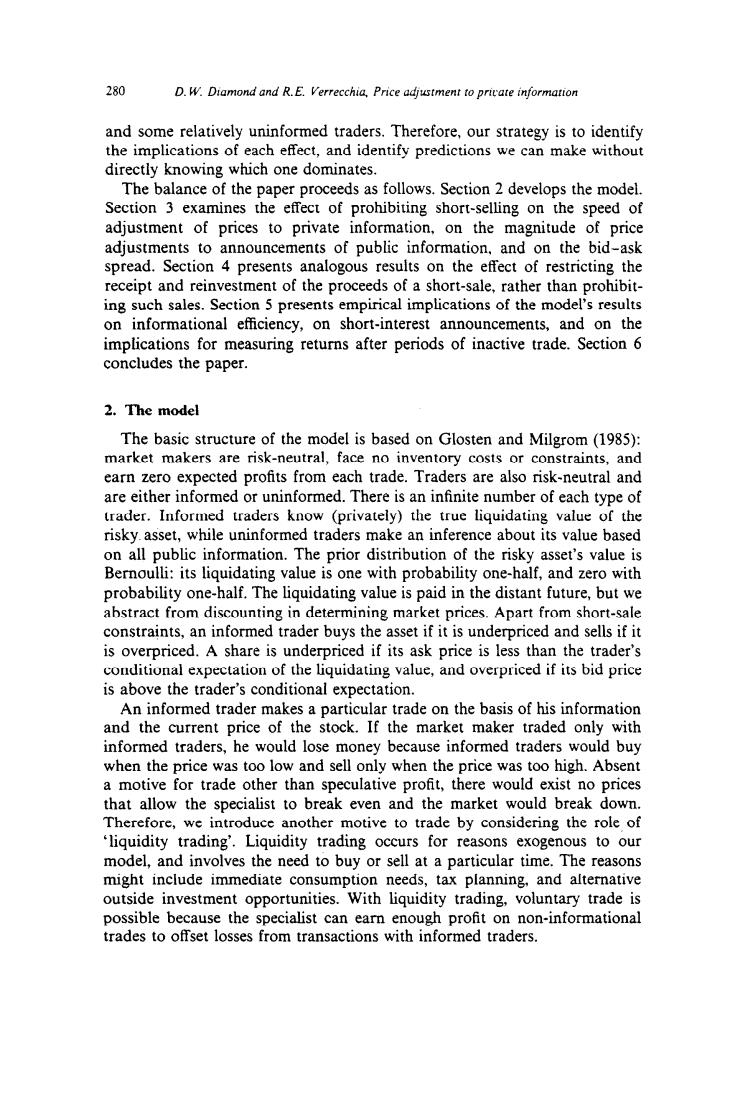正在加载图片...

280 D.W.Diamond and R.E.Verrecchia,Price adjustment to pricate information and some relatively uninformed traders.Therefore,our strategy is to identify the implications of each effect,and identify predictions we can make without directly knowing which one dominates. The balance of the paper proceeds as follows.Section 2 develops the model. Section 3 examines the effect of prohibiting short-selling on the speed of adjustment of prices to private information,on the magnitude of price adjustments to announcements of public information,and on the bid-ask spread.Section 4 presents analogous results on the effect of restricting the receipt and reinvestment of the proceeds of a short-sale,rather than prohibit- ing such sales.Section 5 presents empirical implications of the model's results on informational efficiency,on short-interest announcements,and on the implications for measuring returns after periods of inactive trade.Section 6 concludes the paper. 2.The model The basic structure of the model is based on Glosten and Milgrom(1985): market makers are risk-neutral,face no inventory costs or constraints,and earn zero expected profits from each trade.Traders are also risk-neutral and are either informed or uninformed.There is an infinite number of each type of trader.Informed traders know (privately)the true liquidating value of the risky.asset,while uninformed traders make an inference about its value based on all public information.The prior distribution of the risky asset's value is Bernoulli:its liquidating value is one with probability one-half,and zero with probability one-half.The liquidating value is paid in the distant future,but we abstract from discounting in determining market prices.Apart from short-sale constraints,an informed trader buys the asset if it is underpriced and sells if it is overpriced.A share is underpriced if its ask price is less than the trader's conditional expectation of the liquidating value,and overpriced if its bid price is above the trader's conditional expectation. An informed trader makes a particular trade on the basis of his information and the current price of the stock.If the market maker traded only with informed traders,he would lose money because informed traders would buy when the price was too low and sell only when the price was too high.Absent a motive for trade other than speculative profit,there would exist no prices that allow the specialist to break even and the market would break down. Therefore,we introduce another motive to trade by considering the role of 'liquidity trading'.Liquidity trading occurs for reasons exogenous to our model,and involves the need to buy or sell at a particular time.The reasons might include immediate consumption needs,tax planning,and alternative outside investment opportunities.With liquidity trading,voluntary trade is possible because the specialist can earn enough profit on non-informational trades to offset losses from transactions with informed traders.280 D. W. Diamond and R. E. Verrecchia, Price arijustment to pncate information and some relatively uninformed traders. Therefore, our strategy is to identify the implications of each effect, and identify predictions we can make without directly knowing which one dominates. The balance of the paper proceeds as follows. Section 2 develops the model. Section 3 examines the effect of prohibiting short-selling on the speed of adjustment of prices to private information, on the magnitude of price adjustments to announcements of public information. and on the bid-ask spread. Section 4 presents analogous results on the effect of restricting the receipt and reinvestment of the proceeds of a short-sale, rather than prohibiting such sales. Section 5 presents empirical implications of the model’s results on informational efficiency, on short-interest announcements, and on the implications for measuring returns after periods of inactive trade. Section 6 concludes the paper. 2. The model The basic structure of the model is based on Glosten and Milgrom (1985): market makers are risk-neutral, face no inventory costs or constraints, and earn zero expected profits from each trade. Traders are also risk-neutral and are either informed or uninformed. There is an infinite number of each type of trader. Informed traders know (privately) the true liquidating value of the risky. asset, while uninformed traders make an inference about its value based on all public information. The prior distribution of the risky asset’s value is Bernoulli: its liquidating value is one with probability one-half, and zero with probability one-half. The liquidating value is paid in the distant future, but we abstract from discounting in determining market prices. Apart from short-sale constraints, an informed trader buys the asset if it is underpriced and sells if it is overpriced. A share is underpriced if its ask price is less than the trader’s conditional expectation of the liquidating value, and overpriced if its bid price is above the trader’s conditional expectation. An informed trader makes a particular trade on the basis of his information and the current price of the stock. If the market maker traded only with informed traders, he would lose money because informed traders would buy when the price was too low and sell only when the price was too high. Absent a motive for trade other than speculative profit, there would exist no prices that allow the specialist to break even and the market would break down. Therefore, we introduce another motive to trade by considering the role, of ‘liquidity trading’. Liquidity trading occurs for reasons exogenous to our model, and involves the need to buy or sell at a particular time. The reasons might include immediate consumption needs, tax planning, and alternative outside investment opportunities. With liquidity trading, voluntary trade is possible because the specialist can earn enough profit on non-informational trades to offset losses from transactions with informed traders